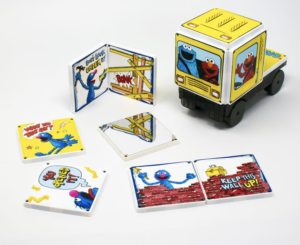
Create On has paired up with every toddler’s favorite theme: Sesame Street. The lovable and furry Grover is the star of the show in the Monster at the End of this Story tiles. Toddler and preschool toy testers loved reading the story, then manipulating the structures to retell it.
Thirteen double sided tiles allowed for open play and various building combinations. First, our preschooler wanted to match up the ways Grover tried to prevent us from turning pages. She found 2 rope tiles, 2 board and nail tiles, and finally 2 brick wall tiles. She set them up next to each other as if they were pages in the story and began to retell her version.
Reading and retelling The Monster at the End of this Story with picture tiles was great for sequencing and early narrative development. Using temporal (or time related) words like “first, next, then, last” allowed for perfect practice in chaining story events together. Telling a sequenced story is critical for strong narrative development and narratives (or storytelling) has been shown to predict language and literacy success.
These awesome Magna-Tiles structures also include 1 chassis, where preschoolers loved building a bus with more Sesame Street favorites, Elmo and Cookie Monster! They eagerly matched the sides together, almost like a puzzle, which was great for building spatial awareness. Moving the bus all around the room and collecting other tiles and objects at “bus stops” allowed for great open play and creating schemas during play.
We also explored different emotions with the 3 feelings tiles: scared, happy, and surprised and made our own emotions with the mirror tile! Our toddler especially loved looking at herself imitating “surprised.” Our preschooler said, “but we missed embarrassed,” referring to the end of The Monster Book when Grover finds out who the real monster is- so we practiced making an embarrassed face in the mirror.
Using Magna-Tiles Structures to retell story favorites is the perfect way to practice story telling, engage in cooperative and open play, promote learning spatial awareness when building, and develop EQ to identify feelings and practice self-regulation strategies.



